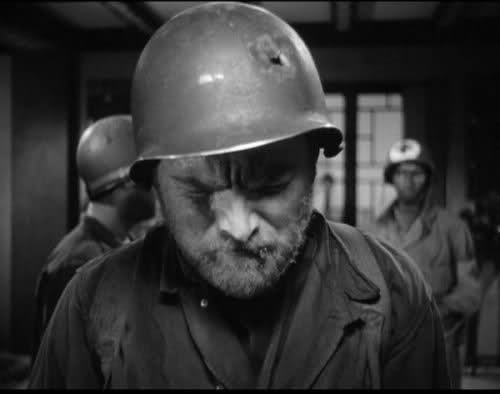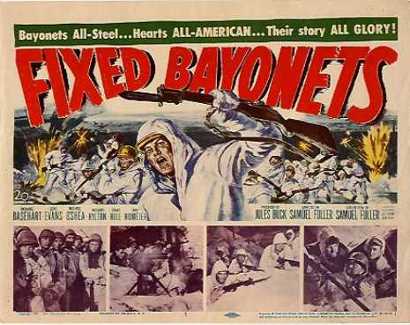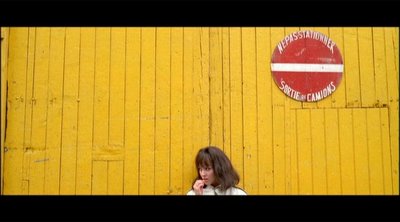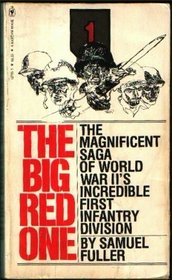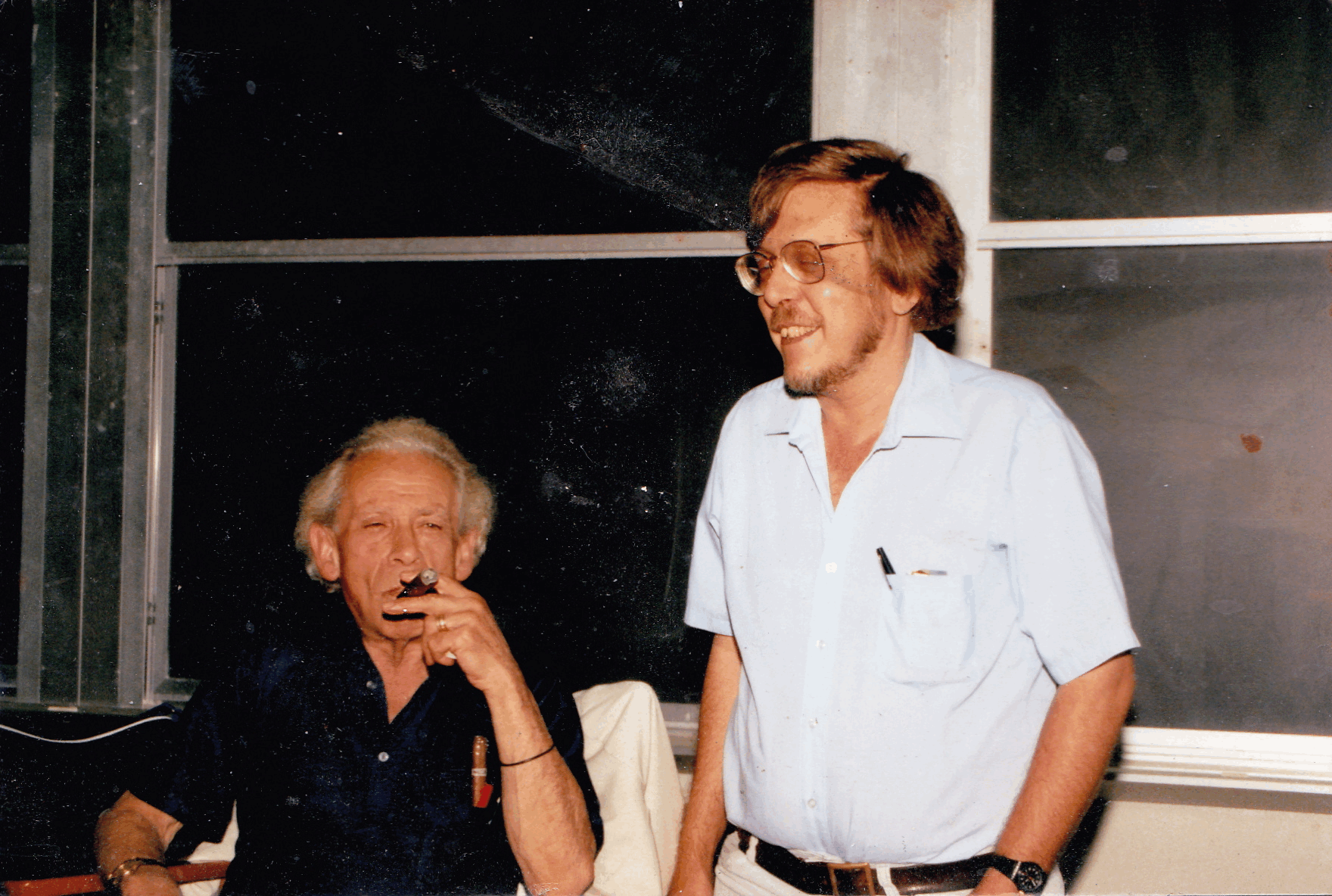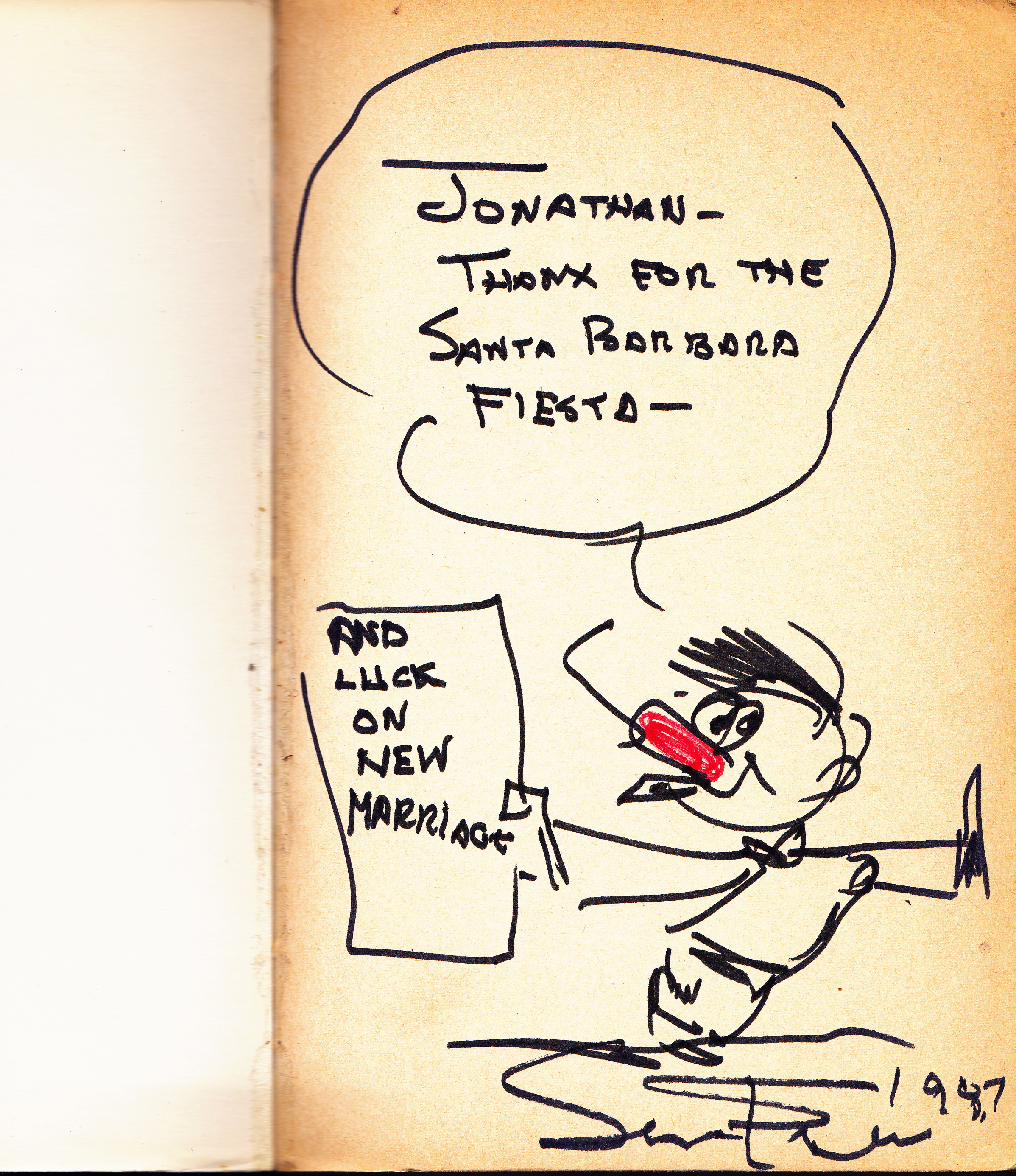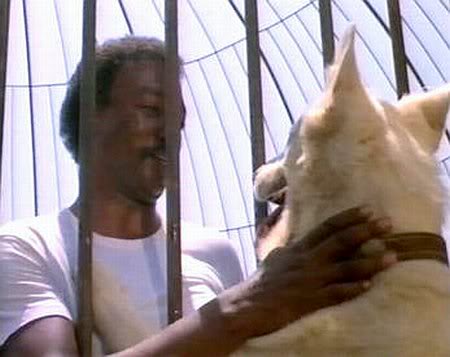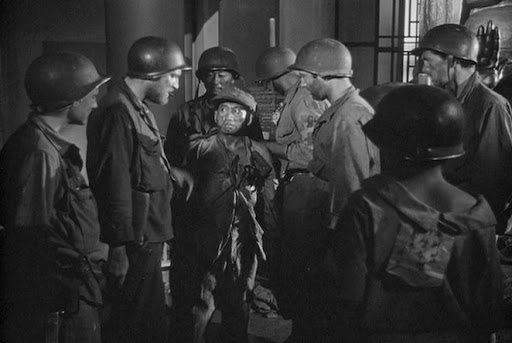From Cinema Scope (Spring 2003). — J.R.
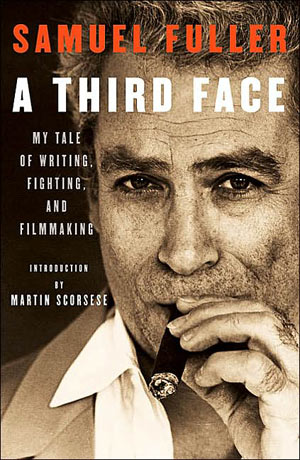
A Third Face: My Tale of Writing, Fighting, and Filmmaking by Samuel Fuller. New York: Alfred A. Knopf, 2002.
Thank God for Beethoven’s music. Ludwig got me though a lot of rough times. He said, “Music is a higher revelation than all wisdom and philosophy.” Holy cow, was he right! — photo caption in A Third Face
Checking my appointment book for 1980, I see that I met Sam Fuller for the first time on June 19, in New York. It was in a suite at the Plaza, where I went to interview him about The Big Red One for the Soho News, and from the moment a publicist opened the door and I was greeted by this short, peppy firecracker, he was already outlining a movie sequence in which I was being kidnapped by a team of Amazons, with the publicist instantly cast as one of the members of the team.
The interview itself was a collection of comparable verbal cadenzas, about life and commerce as well as cinema — with occasional off-the-record asides, like asking me at one point if I’d seen Jean-Luc Godard’s Made in USA, and what I thought of it. I’d seen and loved that movie, and knew it was dedicated “to Nick and Sam, who taught me about sound and image.” But since I also knew that by reputation Fuller was a wild man from Borneo — a “primitive” whose mind was supposedly sub-Neanderthal — I hadn’t expected him to be hip to what Godard was doing in one of his most avant-garde features, even if he was one of the two directors it was dedicated to (along with Nicholas Ray). And his question proved to be neither a sly form of bragging nor a sign of any bewilderment; it was a serious invitation to speak with him as a peer about an interesting movie.
How much of this was putting on a show? As I came to know Sam and his boundless energy better, I discovered that in his case such a question was meaningless, because for him punchy journalism was virtually synonymous with life. So when he presented me with a paperback copy of his just-published novel The Big Red One, and signed it, “June 19, 1980…JONATHAN — TRY TO SURVIVE WITH MY LUCK. Sam Fuller,” it was both a publicity flourish (other interviewers got the same book with the same basic inscription) and a sincere gesture. A similar duality was apparent in his clear dissatisfactions with the re-editing of The Big Red One, which he spoke about in detail, and his willingness to hawk the movie just the same. And the same thing applied to his behavior while holding court at a promotional dinner I attended a month later. (Given both his imagination and his storytelling gifts, it’s small wonder that he was sometimes regarded as a teller of tall tales, because he sometimes believed his own stories; I suspect this is why he once told me that his mother was Irish — a hyperbolic extension of the fact that she liked Irish whisky.)
Seven years later, when I was on the verge of quitting academia for a reviewing post at the Chicago Reader, I was put in charge of running the summer school in Film Studies at the University of California, Santa Barbara, where I’d been teaching in a dead-end position for four years, and persuaded Fuller to fly there from Paris to serve as our artist in residence for eight days. He visited every course being taught at the summer school (I’d arranged for them all to show at least one of his films, and he also talked about John Ford’s The Informer, one of his favorites), attended a local retrospective and a few other programs, and every night when we went off to dinner — usually with other faculty members in tow, including Paul Jarrico (the one-time producer of Salt of the Earth) and Thomas Elsaesser — we typically closed the restaurant four or five hours later. This concluded with our traveling together to Berkeley for a couple of evening programs at the Pacific Film Archives. Before he flew back to Paris, he asked if he could read my autobiographical book Moving Places on the plane, and I managed to find him a used copy at Moe’s. (His subsequent response was mainly favorable, though he objected to me selecting On Moonlight Bay as the focus of my longest chapter, arguing that I should have picked a movie that was more familiar to an 80s readership.) I also treasure the cartoon he drew for me of himself in one of his books, wishing me “luck on new marriage”– newspaper lingo alluding to my forthcoming job at the Chicago Reader.
For the next few years, I saw him with his wife Christa and sometimes his daughter Samantha on trips to Paris, spent more time with him when he was guest of honor at Locarno, and then visited him once again after he suffered a stroke that made him semi-speechless, shortly before he moved back to his house in the Hollywood hills —- and wound up dedicating my 1997 collection Movies as Politics to him shortly before he died at 85 the same year. All of which is to suggest that my friendship with him —- more typical than unique given his sociability —- gives me a particular investment in his autobiography, written with and completed by Christa (who also collaborated on many of his other late writing projects, and who has remained a friend) with the editorial guidance of Jerome Henry Rudes. I’d go further and say that I valued and still value Fuller as a person even more than I value his films, though in many ways I find it difficult to separate the two.
***
I must confess that I still prefer his and Christa’s original title, A Fuller Life, to Knopf’s much less memorable replacement. But in most other respects A Third Face is everything I hoped it would be. Most importantly, it clarifies all the facets of Fuller’s life and personality that have been sorely in need of rectification due to the mantra-like recurrences of words like “primitive,” “macho,” “anti-communist,” and “right-wing” in relation to his life and work. The first three are inexact and therefore misleading — especially in relation to such matters as his literary taste (which extended to such writers as Flaubert, Faulkner, Genet, and Rimbaud), his feminism and devotion to strong women, and his immediate rapport with many communists and extreme leftists, including, within my own experience, Jarrico and Ken Loach — while the fourth is simply wrong. (Curiously, adjectives like “working-class” and “street-smart,” which might have served much better in describing him, almost never came up.)
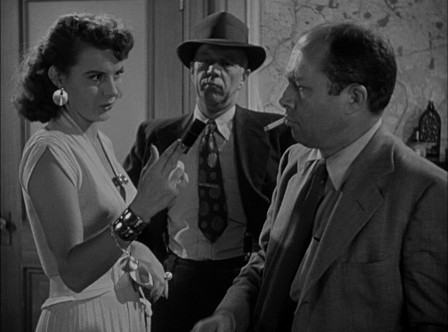
It’s worth pointing out that the “Commie” agents in Pickup on South Street have even less of a relation to communism than the lunatics of Shock Corridor have a relation to mental illness; in both cases we’re talking about generic props (and, in the case of the latter, thematic launching pads). As Fuller puts it, “I had no intention of making a political statement in Pickup, none whatsoever. My yarn is a noir thriller about marginal people, nothing more, nothing less.” Furthermore, the misunderstandings were in some ways even worse in France than they were in the U.S., and not only because of communist detractors like Georges Sadoul; when Luc Moullet — Fuller’s biggest French supporter and a left wing anarchist — argued on his behalf that “fascism is beautiful,” he was muddying the waters even more.
But this hasn’t prevented commentators from trotting out these labels over the past half-century, whenever they wanted to resolve certain apparent anomalies and paradoxes in Fuller’s sensibility, such as the coexistence of liberal convictions and extreme pessimism. Even worse, it was the groundless charge of racism — voiced in various ways by diverse individuals (including even Manny Farber, the first American critic who recognized his talent, and who was in fact critiquing some of the suppositions of his liberalism) — that was probably most responsible for Fuller’s 13 years of exile after the non-release of his last major film, White Dog, his clearest and most unequivocal antiracist statement.
A Third Face also helps to fill in a few grey areas in his life that I hoped this book would engage with, such as his Jewish background and his first marriage. It turns out that his father Benjamin — who died when he was 11, and remains a shadowy figure in this book — was religious, but his strong-willed and much more influential mother, Rebecca Baum, wasn’t. I also suspect that his relative reticence about his ethnic background — despite the fact that he often made me think of Old Testament prophets, and that he once played the part of the Jewish historian Flavius Josephus in a pageant staged in a Roman amphitheater in Sicily by Amos Gitai — stemmed in part from the difficulties of being Jewish outside of Hollywood during his formative years. And bad memories of his first marriage combined with Christa’s participation in the writing probably explains why the material about Martha Downes is relatively attenuated.
Perhaps the book’s most impressive achievement is its extended treatment of Fuller’s war experience in all its complexity. Many portions of this have already been familiar from his war films and novels and some of the anecdotes and details that have cropped up in interviews, but two things that he avoided in these accounts are the persistent nightmares he had about the war for years afterwards and his own generosity towards his fellow soldiers. (One of the book’s most touching episodes, occurring near the war’s end, transpires after Howard Hawks bought the screen rights to Fuller’s first novel for $15,000 and all this was sent by Fuller’s instructions to his mother for her support. She mailed him $1,000 in cash, and he wound up blowing it all on a party for his buddies in a French whorehouse where the madam was instructed to satisfy every request for food, drink, and kinky sex.)
***
Citing both Candide and Don Quijote de la Mancha as role models in his opening chapter, Fuller acknowledges his innocence at the outset, and he’s not being arch about it. (I can’t recall him ever being arch about anything; along with sarcasm, I suspect it was foreign to his nature.) Indeed, his career as a journalist — which started at age 12 and only abated when he enlisted in the army at 29 – can largely be charted through adopted parental figures, starting with Arthur Brisbane (editor of the New York Journal, whom he worked for as copyboy) and continuing with Emile Henri Gauvreau (editor of the New York Evening Graphic) and two ace reporters, Rhea Gore (the mother of John Huston) and Gene Fowler.
He doesn’t direct his first picture until almost halfway through this 593-page book, and although the four years of the war understandably consumes many more pages than his journalism and his life before journalism combined, it helps us to understand how the subsequent 40-odd years of filmmaking were both shaped and inflected by his two previous careers. That’s why the newspaper staff in his Park Row (1952) — his favorite among his own pictures, and easily the most neglected – is basically a squad, as he once admitted to me, and why The Steel Helmet — the best of his released war pictures, made the previous year — is visually and thematically organized like a series of headlines and punchy newspaper topics.
Despite his friendship with John Ford, I don’t think it makes much sense to link Fuller too closely with him or Hawks or Walsh or the other major macho Hollywood directors of that generation. For one thing, those other guys would rather spit blood than refer to themselves as artists, whereas such an appellation didn’t bother Sam at all, even though he was just as wedded as they were to a populist and mainstream sense of what an audience was.
Yet Fuller was less of a journeyman or a studio fixture than those other guys, and, paradoxical as this may sound, more of an aesthete. One thing that suggests this is “The Works of Samuel Fuller,” a six-page catalogue of his oeuvre that virtually concludes this book. At first glance, it’s comprehensive and complete: 24 directed films, 23 film performances, 46 produced screenplays, 11 published books, and 19 unproduced “screenplays, plays, stories, and treatments”. But in fact there are omissions, including two of the last films he directed (The Madonna and the Dragon and The Day of Reckoning, both for European TV) and at least a couple of books, his novelization of The Naked Kiss (1964) and New York in the 1930s (1997). It’s interesting, moreover, that only one of the things he directed for TV (330 Independence S.W., an episode in The Dick Powell Show) gets mentioned in the first list while all the others — one episode for The Virginian, five for The Iron Horse — get mentioned only in the third.
I suppose I could be making too much of this, since what I’m reading as conscious and self-critical omissions theoretically might in some cases be oversights. But I remember how dead set Sam was against my showing any of his TV work in the retrospective of his work that I programmed in Santa Barbara, clearly drawing a line between what he regarded as his work and what he considered meat-and-potato assignments. And I suspect that what he valued in his oeuvre wasn’t just its didactic or its formal and technical aspects, which he tended to emphasize in his interviews, but also its moral and ideological coherence.
The fact that we generally weren’t supposed to like Fuller’s heroes is probably what wound up confusing critics the most, because his grasp of what was good and what was evil—-which seemed to come mainly from what he witnessed as a crime reporter and a soldier — could almost never be applied to characters who were either simply heroes or simply villains. (In this respect alone, he was anything but a primitive.)
Nearly all his characters were both — Thelma Ritter’s Moe in Pickup on South Street, a tender and victimized stool pigeon, was just as emblematic of this dual tendency as the oafish, hate-filled protagonists of The Steel Helmet and Run of the Arrow. Whether you liked them or not was ultimately irrelevant; they existed in order to show us how the world worked. And the world is an awful, irredeemable place in Sam’s movies, but I never knew anyone who got more pleasure out of life. Maybe that’s because, appearances to the contrary, the world and life aren’t the same thing, and it takes an artist as singular as Sam Fuller to show us why.
